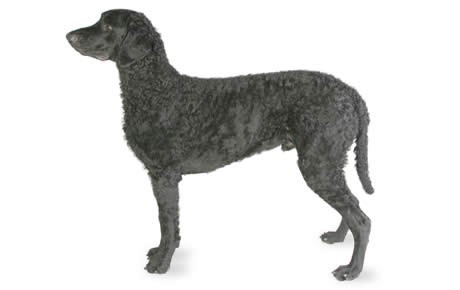Curly-Coated Retriever Breed Guide

Breed Group:
Sporting Dogs
Get 30% off
Join our Newsletter
Sign Up Today
Curly-Coated Retriever Background Info and History
The Curly-Coated Retriever (CCR) is one of the oldest retriever breeds. CCRs were first developed in Newfoundland. They were bred from a variety of breeds, including native water dogs from Newfoundland, retrieving setters, the English Water Spaniel, Irish Water Spaniel, and Poodle. CCRs are a medium sized breed that is regarded as a valuable hunting retriever. CCRs were first brought to England in the 1800’s, and made their first appearance in the United States in 1907.
Curly-Coated Retriever Temperament and Personality
Modern Curly-Coated Retrievers are most often kept as a companion dog. They serve well in this role, as they are a gentle and affectionate breed that is well-mannered in the household. CCRs are a proud breed that displays a high level of self-confidence in both their bearing and mannerisms.
Curly-Coated Retriever Training Tips
CCRs are intelligent and intuitive, making them a very trainable breed. They mature slowly, so owners must exercise patience and care when training this breed. Training and socialization should begin at a young age, as they can be reserved with strangers.
Curly-Coated Retriever Exercise Needs
CCRs have a high amount of energy and are renowned for their endurance and work ethic. Owners will need to provide their CCR with a long daily walk, jog, or play session. CCRs love water sports and will excel with regular swimming exercise.
Lifespan of Curly-Coated Retrievers
Curly-Coated Retrievers live between 11-13 years.
Curly-Coated Retriever Breed Popularity
CCRs are currently the 164th most popular AKC registered breed.
Feeding Requirements of Curly-Coated Retrievers
CCRs will need a high-quality food source from the time they are a puppy. Adult CCRs weigh between 60 and 95 lbs., so feeding requirements will vary depending on the weight and activity level of your specific dog. The average CCR will need to be fed between 3 and 4 cups of dry food a day, split between two even meals.
Curly-Coated Retriever Grooming
The CCR’s unique coat is very easy to care for. This breed will only require occasional brushing and bathing. Be sure to make trimming the nails and checking your pups ears and eyes a regular part of your grooming process.
Are Curly-Coated Retrievers Good With Kids?
CCRs are known as excellent companions for older children. Play with younger children should be supervised, as CCR puppies and adolescents have a rambunctious play style that can easily lead to children being knocked over.
Curly-Coated Retriever Health Problems
Hip Dysplasia
Hip dysplasia in dogs is a common condition affecting almost all breeds. This condition is caused by a loose fit between the femur and the pelvis in the rear hip assembly. The loose fit between these two bones causes the cartilage padding the bones to wear down unevenly over time.
Uneven wear on the cartilage leads to painful arthritis, bone spurs, and limited functionality in the rear limbs later in life. Hip dysplasia can be diagnosed early in a dog’s life by a physical examination by a veterinarian. Care should also be used during the puppy growth period to not over-exercise your CCR.
Elbow Dysplasia
Elbow dysplasia in dogs is a condition that results from uneven growth at the elbow joint between the radius and ulna. Elbow dysplasia is believed to be caused by a combination of factors including genetics, trauma, diet, and exercise. CCRs with elbow dysplasia will almost certainly show signs of pain or lameness in their front limb or limbs.
Pay attention for lameness following exercise, slow recovery, and progressively worsening symptoms. Elbow dysplasia most commonly appears during the period of puppy growth in large breeds. Over time, the damage caused in the elbow joint by a poor connection will result in painful arthritis and canine lameness.
Cataracts
Cataracts are a disease that affects both dogs and humans. With this condition, the lens of the eye becomes cloudy or occluded. At first, canine cataracts will usually not affect your dog’s ability to see. However, as the disease progresses, cataracts can lead to partial or even full loss of vision.
Cataracts are an inherited disease, so be sure to inquire with your breeder if there is a history of cataracts in your dog’s line. Cataracts can usually be surgically treated, so be sure to examine your dog’s eyes during your grooming sessions for any cloudiness.
Distichiasis
Distichiasis is a condition where an extra row of eyelashes grows on a dog’s eye and protrude from the edge of the eyelid. These eyelashes can irritate the cornea. In minor cases these eyelashes merely serve as an irritant, causing the eye to water or your CCR to rub his eyes repeatedly. In more severe cases, these extra eyelashes can cause abrasion on the cornea, resulting in scarring and damage to the eye. Distichiasis is generally treated surgically.
Other Resources
National Breed Website: Curly-Coated Retriever Club of America
Rescue: CCRCA Rescue
Health Issues Associated with this Breed:
- Adenocarcinoma
- Arthritis
- Bloat/Torsion/GDV
- Dermatitis
- Distichiasis
- Ectropion
- Elbow Dysplasia
- Entropion
- Fibrosarcoma
- Glycogen Storage Disease (GSD)
- Hemangiosarcoma
- Hip Dysplasia
- Inflammation
- Lymphosarcoma
- Mast Cell Tumors
- Melanoma
- Osteosarcoma
- Pain
- Pattern Baldness
- Persistent Pupillary Membranes (PPM)
- Progressive Retinal Atrophy (PRA)
- Retinal dysplasia





